Tuna adventure ends with delicious Albacore Poke
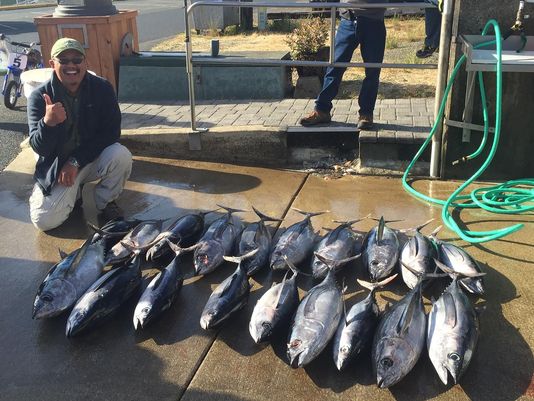
I pose for a picture with the boat’s catch of the day. The two albacore that I caught are nearest me.
Ever since I became and avid fisherman not long after moving to Oregon, I’ve dreamed of fishing for albacore tuna.
But the hefty cost, time commitment and other things conspired to keep it an unrealized dream for nearly 10 years.
Finally, the past week during my two-week staycation, my spouse and my mother gave me an early birthday present: a tuna fishing trip with Dockside Charters out of Depoe Bay.
I was so ridden with anticipation the night before driving out to the coast that I only got about three hours of sleep. Three-thirty in the morning on July 17 came after a very light sleep. I didn’t even need the alarm to wake up.
It took me about an hour and a half to make it from Salem to Depoe Bay. I pulled into the parking lot at Dockside Charters at 5:20 a.m., and the sky to the east was just beginning to show a hint of sunrise.
After checking in, I headed to the dock and the boat at the end, the Kadaho. By 6 a.m., all of the people on the charter had arrived, and the boat slowly pulled away from the dock and barreled through the channel out toward open ocean. Sea lions were sunning themselves in the morning sunlight on the rocks that lined the channel.
From shore, it looked like calm seas. But once out on the open ocean, it was a different story. As the boat plowed into wave after wave and sent spray over the roof of the cabin and onto some of us who were seating on the aft deck, two of the people on the charter headed to the railing and spilled their stomachs into the foamy ocean. The captain had warned us that there usually were one or two people on every trip who got sick and cautioned us to heave toward the ocean instead of inside the cabin or on deck.
I felt sorry for the two guys who, after a few seconds of hurling, went into the cabin. They looked white as sheets. They didn’t reappear again until about midday.
By about 8 a.m., we were about 35 miles offshore, and the deckhand began to set the rods into the holders on the railing and let the lines out. Dangling from each was an artificial lure that looked comical to me. Two beady eyes attached to a skirt of brightly colored plastic hiding two very large barbless hooks, they looked like a child’s caricature of what a squid might look like. The rods were set in a fan like a peacock’s tail from the aft of the boat, each with differing lengths of line trailing so they wouldn’t get tangled.
The captain slowed the boat, and we began trolling back and forth, turning in broad circles. It was like sitting in an amusement park ride. The boat alternately swayed from side to side, dipping and climbing as each wave passed broadside and then rocked fore and aft as the boat turned and climbed into waves and then sank between them. I looked back at the cabin, and the two seasick fishermen were still out cold.
It seemed like forever before the first tuna struck. We had passed the time admiring a gray whale that was slamming its tail on the surface of the water a few hundred yards away from the boat, and then it jumped into the air, nearly rising three quarters of its body above the surface before splashing back down. On the port side, a school of dolphins raced the boat. Right after they passed us, the first tuna took a bait, and one of the passengers who had come all the way from Boise, Idaho, for the adventure, took the rod and began reeling.
He was surprised, as I was when I reeled in my first tuna: The fish was pulling line from the reel and headed in the opposite direction that the boat was traveling. It was swimming fast, and the reel was screaming at high pitch.
The reels are set with tension strong enough to keep the lines from unreeling as the boat is trolling, but not so strong as to prevent a tuna from pulling line out of the reel. The deck hand later explained to us that if the tension is set too tight, the line would simply snap from the strength of the tuna.
After alternatively reeling and catching his breath for what seemed like four or five minutes, the guy from Boise finally reeled the tuna in close enough for us to see it just below the surface, the fish’s silver belly flashing the sunlight back at us as it fluttered back and forth, struggling to get away. The deck hand reached over and grabbed the line and lowered the gaff (a pole with a sharp hook on the end) toward the surface. But just at that moment, the fish caught his second wind and darted away from the boat, pulling more line away with it as it tried to get away.
The guy from Boise let out a string of expletives beginning with “mother” and ending with “it.” He took a deep breath and went back at it, pulling the rod up in an arch and reeling in line as he lowered the rod, up and down, reeling and reeling, until the fish was again near the surface at the stern of the boat.
This time, the deckhand hooked the fish right under the gills and hauled it aboard. The fish flickered its tail fast, beating it like a drumstick against the deck. The deckhand grabbed the fish, reached behind the gills and pulled out a small organ and dumped the fish headfirst into a plastic tub with channels in it so that the blood could drain from the fish.
The initial sight of this repulsed me a little bit. I knew from talking to chefs that albacore had to be properly drained of blood right after they’re caught or they develop an off flavor. But seeing the process for the first time was a little unnerving. The tail was still swishing back and forth at lightning speed as if the fish were still trying to swim away. After a minute or two, it finally stopped.
During this time, the deckhand was busy getting the rod back into the water and letting out line.
Someone behind me yelled suddenly “fish on,” pointed at the rod next to me and pushed me to it. As I struggled to get my balance against the rocking boat and leaned against the railing to begin reeling the fish in, I heard more yelling “fish on!, fish on!, fish on!” Four tuna had taken baits within moments of each other, and four us of were at the rods, alternately reeling and pulling the rods up into the air and reeling in more as we lowered the rods as the fish got closer and closer. By this time, the captain had left the boat on autopilot and came back to the deck with a net. It seemed like four or five minutes transpired, but one after another, the tuna were netted or gaffed and brought aboard.
As we caught our breaths, the captain explained that often, when a fishing boat passes through a school of tuna, multiple lines will be struck by different tuna in the school and we should all grab a rod and start reeling. Others who weren’t reeling in fish were helping to reel in the other rods to get them out of our way so the lines wouldn’t get tangled among the fish. For those of us at the rear-most corners of the boat, other people were grabbing onto the belts of those reeling in fish so that they wouldn’t lose their footing as the boat heaved to and fro with the waves.
The scene played out again a few times, with three tuna or four tuna striking at the same time as the boat crisscrossed the ocean passing through schools of fish that were invisible to us aboard.
There were 11 of us fishing that day, and we all made sure everyone got at least two turns at a rod when it was struck by a fish. I reeled in two fish; a third fell off the hook as the deckhand was reaching to gaffe it. By the time we got back to the dock 12 hours after we had left, and we made our way back up to the charter office and waited at the fish-cleaning table outside, we were sunburned and worn out. When a dock hand hauled our catch and laid it out on the concrete pavement, it finally hit us how big some of the tuna were, some reaching about 3 feet long from head to fin tip.
There were 19 glistening tuna staring up from the pavement.
One by one, the fish were skinned, four tenderloins removed from each fish and set into tubs, and then the rest of the fish was thrown into huge rubber bins. We paid the people who cleaned the fish, divided the catch among us and headed to our cars with tuna loins stuffed into bags or vacuum packed for an extra charge.
The day after I got back from the coast, we had our first taste of my catch, I made albacore poke, an adaptation of a Hawaiian dish, with a piece of raw tuna tenderloin that I had left in the fridge. It tasted amazing. The rest of the tuna was stashed in the freezer.
It was the best birthday present ever. Thanks Charles and Mom.
Albacore Tuna Poke
Serves 4 to 6 as appetizer
Ingredients
- 1 pound sushi grade albacore tuna cut into 1/2-inch dice*
- 1/2 cup sweet onion, finely diced
- 1/2 cup English cucumber, peeled, sliced into disks and then quartered
- 3 tablespoons soy sauce
- 2 teaspoons toasted sesame oil
- Juice from half of a lime
- 1/4 cup scallions, thinly sliced
- 2 teaspoon toasted sesame seeds
Directions
Combine albacore, onion, cucumber in a bowl. Add soy sauce, sesame oil and lime juice and toss until thorougly mixed. Add scallions and toss, top with sesame seeds and serve.
*NOTE: if eating raw fish bothers you, sear the tuna before dicing.
About the Author (Author Profile)
Victor Panichkul is a journalist and writer by training; a cook, wine lover and photographer by passion; and a lover of the outdoors since moving to Oregon more than 10 years ago. He is a native of Bangkok, Thailand.
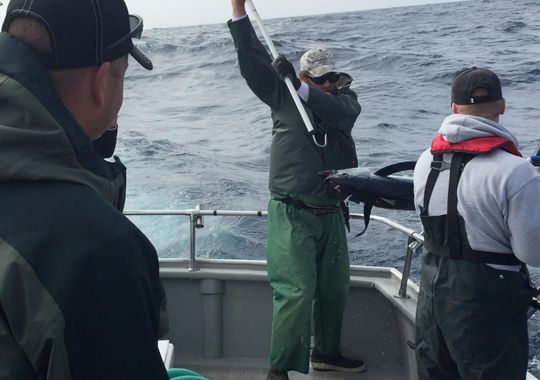







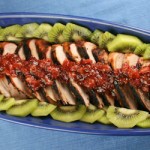





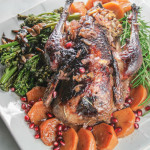

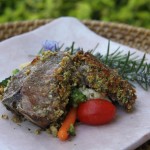
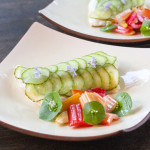
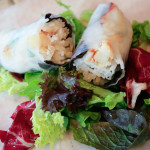
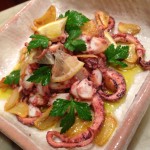







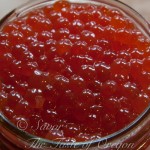




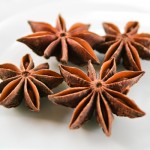














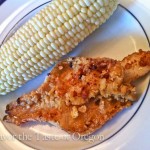



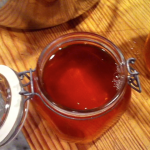











Wow! What a great experience…..I, however, would most likely been one of the sick ones. So I will leave the fishing to others and just be willing to pay for the tuna!!
This is a great story. What an incredible day!
What an adventure, Vic and a very belated happy birthday to you!
Barbara